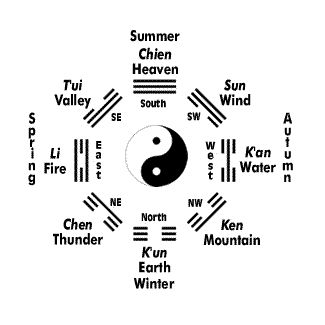Yin, Yang, and a Little Feng Shui
In most ancient –and not so ancient–societies competing religions often fought for the control of the hearts and minds of the people. History is full of stories of wars in the name of religion. Not so in ancient China. During the time of the Han emperor Wudi–seen by many to be the greatest of all Han emperors– the three competing philosophies of Taoism, Buddhism, and Confucianism were brought together in harmony in what the Chinese call the Three Ways.
The Three Ways worked together so well because each school of thought brought something unique to the mix which was similar enough to the other to so that no one philosophy was able to dominate the other. We like to think of it as a philosophical Trail Mix.
Taoism is the most mysterious of the three ways. The main focus of Taoism is that everything in the universe comes from and is connected to a life force or energy simply known as the Tao. The universe itself is made up of five elements called Wu Xing: wood, water, fire, earth, and metal. The Taoist way of understanding how the world works is explained through the Wu Xing.
At different seasons one of the five elements was dominating the other. For example, fire burns wood. This is not necessarily a bad thing because burned wood creates ash which is what the element earth is made from. Think of it like the game Rock, Paper, Scissors. The five elements corresponded to the five directions– north, south, east, west, and center which then matched up with the five primary colors– black, white, red, yellow, blue, and green; which then matched up with the five sacred animals–tortoise, bird, tiger, dragon, and man.
Simply put the Tao is about balancing competing forces: fire and water, dark and light, cold and hot, etc. No one force should be greater than the other–when that happens you get all sorts of nastiness such as war, famine, unhappiness, and chaos. The ancient Chinese represented this balance in the Yin Yang symbol made up of a dark swirl and a light swirl each containing a dot of the other element. Yin Yang is the perfect balance because in Chinese thinking there is no such thing as purely good or purely evil, everything has a little of each.
Achieving balance between the forces of Yin and Yang was so important to the ancient Chinese that they built entire cities around these ideas. The Han capital of Chang’an was built along a north south axis with its five palaces facing to the south to maximize the benefits of the Sun–a Yang element. Homes, palaces, and cities could not be built without first consulting a geomancer who would study the flow of nearby river, the lay of the land, the direction of the sun and then advise how the building should be constructed.
Each of the four corners of a traditional Chinese building was supposed to conform to the four directions. Perhaps you’ve heard of the art of Feng Shui. This takes this concept one step further where a Feng Shui professional will help you arrange your home or business decoration scheme based on the principals of the Tao. A Feng Shui artist is a type of geomancer who enters the home to determine what elements are out of balance. Perhaps a house has too much wood in a certain room or the furniture is facing a direction that causes disharmony of the qi. A Feng Shui artist will use the knowledge of Yin and Yang to correct these imbalances helping the occupants achieve greater harmony in their lives.

The Yin Yang Symbol shows the balance between opposing forces in nature, a key concept in Taoism

The magnetic compass is an old Chinese invention, probably first made in China during the Qin dynasty (221-206 B.C.). Chinese fortune tellers used lodestones (a mineral composed of an iron oxide which aligns itself in a north-south direction) to construct their fortune telling boards. Eventually someone noticed that the lodestones were better at pointing out real directions, leading to the first compasses.
Source: About.com



